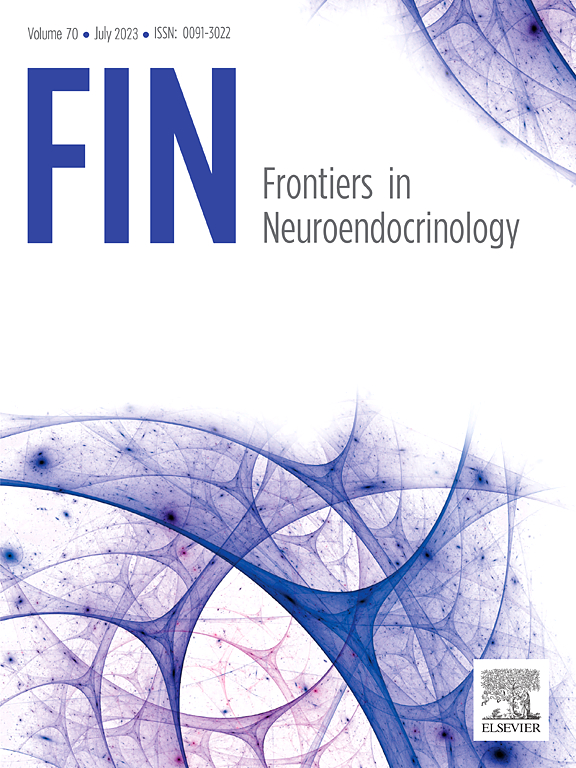Cortisol in schizophrenia spectrum disorders: A comprehensive meta-analysis
IF 6.7
1区 医学
Q1 ENDOCRINOLOGY & METABOLISM
引用次数: 0
Abstract
Schizophrenia spectrum disorders (SSD) are characterized by alterations in cortisol levels across various parameters, including stress reactivity, hair cortisol, and baseline levels, which may be influenced by antipsychotic treatment. To provide a comprehensive overview of cortisol dysregulation in SSD, we conducted meta-analyses assessing (1) the effects of antipsychotic treatment in SSD patients, and additionally comparing cortisol in SSD patients versus healthy controls (HC) (2) following stress induction (metabolic, physiological, psychological stressors), (3) in hair and (4) baseline levels. Systematic literature searches in PubMed, Web of Science, and PsycINFO (November 2024) identified 121 studies (9049 SSD patients) for inclusion. Meta-analytic results revealed that antipsychotic treatment significantly reduced cortisol levels in SSD (k = 16, g = -0.480, 95 % CI [-0.818, −0.142], p = 0.005). Additionally, compared to HC, SSD was associated with reduced cortisol suppression following dexamethasone exposure (k = 9, g = 0.299, 95 % CI [0.091, 0.507], p = 0.005) and with elevated baseline cortisol levels in the morning (k = 71, g = 0.38, 95 % CI [0.210, 0.546], p < 0.001) and evening (k = 11, g = 0.368, 95 % CI [0.076, 0.661], p = 0.014). However, there were no significant group differences in afternoon baseline cortisol, hair cortisol or cortisol reactivity to stress (p > 0.05). These findings offer a detailed understanding of cortisol alterations in SSD and improve our understanding of HPA axis dysregulation in SSD.
精神分裂症谱系障碍中的皮质醇:一项综合荟萃分析
精神分裂症谱系障碍(SSD)的特征是皮质醇水平在各种参数上的改变,包括应激反应性、毛发皮质醇和基线水平,这可能受到抗精神病治疗的影响。为了全面概述SSD患者的皮质醇失调,我们进行了荟萃分析,评估(1)SSD患者抗精神病治疗的效果,并比较SSD患者与健康对照(HC)(2)应激诱导(代谢、生理、心理应激源)后的皮质醇水平,(3)头发和(4)基线水平。在PubMed, Web of Science和PsycINFO(2024年11月)进行系统文献检索,确定了121项研究(9049名SSD患者)纳入。荟萃分析结果显示,抗精神病药物治疗显著降低了SSD患者的皮质醇水平(k = 16, g = -0.480, 95% CI [-0.818, - 0.142], p = 0.005)。此外,与HC相比,SSD与地塞米松暴露后皮质醇抑制降低相关(k = 9, g = 0.299, 95% CI [0.091, 0.507], p = 0.005),与早晨基线皮质醇水平升高相关(k = 71, g = 0.38, 95% CI [0.210, 0.546], p <;0.001)和晚上(k = 11, g = 0.368, 95% CI [0.076, 0.661], p = 0.014)。然而,在下午基线皮质醇、毛发皮质醇和皮质醇对压力的反应性方面,组间无显著差异(p >;0.05)。这些发现提供了SSD中皮质醇变化的详细理解,并提高了我们对SSD中HPA轴失调的理解。
本文章由计算机程序翻译,如有差异,请以英文原文为准。
求助全文
约1分钟内获得全文
求助全文
来源期刊

Frontiers in Neuroendocrinology
医学-内分泌学与代谢
CiteScore
13.30
自引率
6.80%
发文量
62
审稿时长
68 days
期刊介绍:
Frontiers in Neuroendocrinology (FIN) publishes a wide range of informative articles including comprehensive reviews, systematic reviews, opinion pieces, and meta-analyses. While the majority of reviews are invited, we also embrace unsolicited reviews and meta-analyses, as well as proposals for thematic special issues, provided they meet our rigorous quality standards. In addition, we encourage authors to submit commentaries that concisely present fresh ideas or offer further analysis to delve deeper into the implications of an article published in our journal.
 求助内容:
求助内容: 应助结果提醒方式:
应助结果提醒方式:


